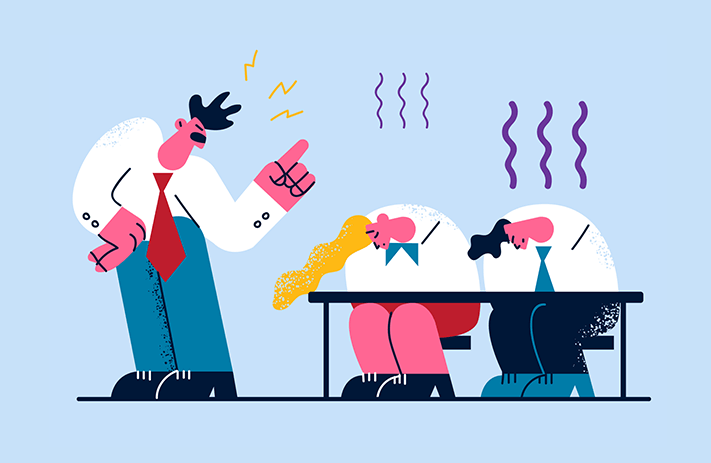
Click the button to start reading
7 Relatable Examples of Social Loafing You’ve Definitely Experienced
Have you ever been part of a group project where some people didn’t seem to be putting in the same effort?
Well, it turns out there’s a psychological phenomenon for that…
It’s called social loafing, and it refers to the tendency of team members to put forth less effort when they’re part of a group. Here are 7 things you’ve probably seen people do when they don’t want to do anything.

1. The Meeting Slacker:
Description:
You notice that a team member consistently shows up late or unprepared for meetings, yet you expect the rest of the team to pick up the slack.
Real-life Example:
John, one of the team members in the marketing department, is always late for meetings and never seems to have his presentation materials ready. As a result, the team has to spend extra time catching him up and making sure his portion of the presentation is ready. The team’s productivity has plummeted, and morale has suffered.
Causes:
John’s lack of motivation, poor time management skills, or a lack of accountability for his activities could all be to blame for this behavior.
Effects:
This conduct might result in decreased productivity, low morale, and poor job quality.
Solutions:
It’s time to establish some very specific expectations for John. After all, while you’re on the clock, time is of the essence. Remind him of the importance of time. But make sure you model and own it so he understands the value of meeting deadlines.

2. The Invisible Team Member:
Description:
You notice that a team member barely contributes or is never heard from, but they expect their name to be on the final project.
Real-life Example:
Sara is part of the company’s annual report team, but she rarely speaks up in meetings, and when she does, her contributions are minimal. Her teammates have noted that she expects her name to be on the final report despite her lack of participation.
Causes:
This behavior points to Sara’s insecurity. Maybe she feels like she needs to be perfect in order to be accepted, so she’s afraid to make mistakes. Or maybe she doesn’t feel safe within your team’s dynamic.
Effects:
This behavior can lead to a lack of cohesion among the group, decreased productivity, and poor quality work.
Solutions:
To remedy this situation, start by creating a safe space for everyone to voice their opinions and ideas. Give Sara the opportunity to share her thoughts without fear of judgment. Also, be sure to recognize and reward her contributions when appropriate. This will create a sense of camaraderie and accountability within the team.

3. The Free Rider:
Description:
This is where you have a team member who’s not pulling their weight, but they’re sure enjoying the benefits of the group’s hard work.
Real-life Example:
Mike is a member of the sales team, but he rarely makes any calls or follows up with leads. Instead, he just sits back and waits for the rest of the team to close deals, and then he takes credit for their work. His lack of effort is affecting the team’s productivity and morale.
Causes:
This behavior might be caused by Mike’s lack of ownership of the project, a lack of clear roles and responsibilities, or a lack of accountability within the team. More often than not, accountability is the underlying cause of a free rider.
Effects:
This behavior can lead to decreased productivity, lowered morale, and poor-quality work. And if you want to build a positive team culture, it’s crucial to address this issue quickly. If not, your team will suffer.
Solutions:
Sometimes leadership is like parenting; you have to be both nurturing and firm. Start by setting clear goals and expectations for Mike, and then follow up with him on his progress. Help him understand the importance of accountability and ownership. And finally, reward his successes publicly to reinforce their hard work.

4. Social Conformity:
Description:
This is when your team member conforms to the group’s norm of loafing and doesn’t put in their best effort.
Real-life Example:
When Greg started working on the project, he had a ton of energy and momentum. But over time, he’s noticed that the team isn’t putting in much effort. Instead of speaking up and challenging the culture, he just follows along with the rest of his team and doesn’t put in any extra effort himself.
Causes:
Greg might not see the value in going above and beyond, or he might feel like it won’t make a difference anyway.
Effects:
This behavior sends a message to the team’s culture that mediocrity is acceptable. It can lead to a decrease in productivity, motivation, and morale.
Solutions:
The best way to get Greg back on track is to set expectations and provide him with meaningful feedback. Reward his efforts and energy and try to get his eyes back on the prize. Most importantly, create a culture of accountability and ownership within the team. Encourage everyone to challenge each other to be better and strive for excellence. Ideally, you would include this in the brief before the project begins so that everyone is working to the same high standards.

5. Bystander Effect:
Description:
Have you ever heard of the bystander effect? It’s when people in a group fail to help someone in need because they assume that someone else will do it. Or, as the name implies, they become bystanders in the situation.
Real-life Example:
During a company meeting, you ask for volunteers for a task. No one in the team speaks up or offers to help, even though they all understand the importance of the project.
Causes:
This is usually caused by a feeling of diffusion of responsibility or an assumption that someone else will take care of it.
Effects:
This can lead to decreased productivity and a lack of ownership within the team. It also shows that the team is not taking ownership of their work, which can be detrimental in the long run.
Solutions:
First off, asking for volunteers is usually a bad idea. When possible, it’s better to actively assign tasks and roles. If you do need volunteers, be clear about the expected outcome and divide tasks into manageable chunks. This will make it easier for people to step up and take ownership of the project.
It’s also great to reward people who do take ownership, to show that their hard work is being appreciated. This doesn’t mean you have to pay more, though financial compensation is always good; just simple social recognition is enough.

6. The “Perfectionist” Loafer:
Description:
This is when someone on your team is waiting for the perfect moment or perfect conditions to start working, ultimately leading to procrastination and reduced effort.
Real-life Example:
Your project has a strict deadline, so you assign certain tasks to your team members and expect them to be completed by a certain date. But one of your team members is constantly pushing back the deadline, saying that it’s not perfect enough or needs more work.
Causes:
Nine times out of ten, this behavior stems from a fear of failure or not wanting to make mistakes.
Effects:
This can lead to a decrease in morale and productivity, as well as missed deadlines.
Solutions:
The best way to address this is by focusing on the progress made rather than the end result. Make sure that your team members are aware of their progress and celebrate small wins along the way. This will help them focus on what’s been accomplished instead of trying to achieve perfection.
Additionally, encourage your team members to ask for help when they feel stuck or overwhelmed with a task. This will show that you’re accessible and willing to provide support, which will make them more comfortable taking risks.

7. The “Too Cool” Loafer:
Description:
They think they’re above the task at hand and put in minimal effort, thinking it won’t affect the outcome of the project.
Real-Life Example:
You assign a task to one of your team members, and they don’t take it seriously. They may joke around or make light of the situation and dismiss the importance of what’s being asked of them.
Causes:
This behavior is often caused by a sense of superiority or arrogance. Most likely, they don’t think the task is worth their time or effort.
Effects:
This can demolish a team’s morale and productivity, as well as lead to missed deadlines or unfinished projects.
Solutions:
This should not be tolerated on any team. It’s a bad way of thinking that can quickly spread to other people on the team if it’s not stopped.
But if you are wanting to remedy this problem without firing the person, the best approach is to make sure they understand how their behavior affects the outcome of the project. Explain why it’s important that everyone contributes, and show them how their work fits into the overall goal. This will help them see the value in what they are doing, as well as bring everyone closer together as a team.
Conclusion
We’ve all encountered it in one way or another.
Social loafing can be a real pain in any collaborative effort, whether you’re the one taking a back seat or trying to compensate for others’ shortcomings. But, through greater consciousness and proactive solutions, this obstacle can be conquered.
Always remember to reward effort and progress, and if all else fails, don’t be afraid to take drastic measures and make sure everyone is on the same page.
It’s in these moments that we can create a truly collaborative and productive team, one where everyone feels valued and respected. That’s when our true potential as a team will shine through! Happy team-building!
















